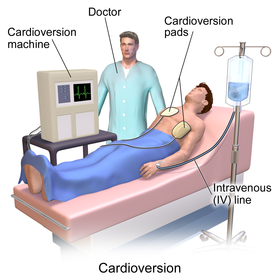Cardioversion
| Cardioversion | |
|---|---|
| Intervention | |

Illustration of cardioversion
|
|
| ICD-9-CM | 99.6 |
| MeSH | D004554 |
Cardioversion is a medical procedure by which an abnormally fast heart rate (tachycardia) or other cardiac arrhythmia is converted to a normal rhythm using electricity or drugs. Synchronized electrical cardioversion uses a therapeutic dose of electric current to the heart at a specific moment in the cardiac cycle, restoring the activity of the electrical conduction system of the heart. (Defibrillation uses a therapeutic dose of electric current to the heart at a random moment in the cardiac cycle, and is the most effective resuscitation measure for cardiac arrest associated with ventricular fibrillation and pulseless ventricular tachycardia.) Pharmacologic cardioversion, also called chemical cardioversion, uses antiarrhythmia medication instead of an electrical shock.
To perform synchronized electrical cardioversion, two electrode pads are used (or, alternatively, the traditional hand-held "paddles"), each comprising a metallic plate which is faced with a saline based conductive gel. The pads are placed on the chest of the patient, or one is placed on the chest and one on the back. These are connected by cables to a machine which has the combined functions of an ECG display screen and the electrical function of a defibrillator. A synchronizing function (either manually operated or automatic) allows the cardioverter to deliver a reversion shock, by way of the pads, of a selected amount of electric current over a predefined number of milliseconds at the optimal moment in the cardiac cycle which corresponds to the R wave of the QRS complex on the ECG. Timing the shock to the R wave prevents the delivery of the shock during the vulnerable period (or relative refractory period) of the cardiac cycle, which could induce ventricular fibrillation. If the patient is conscious, various drugs are often used to help sedate the patient and make the procedure more tolerable. However, if the patient is hemodynamically unstable or unconscious, the shock is given immediately upon confirmation of the arrhythmia. When synchronized electrical cardioversion is performed as an elective procedure, the shocks can be performed in conjunction with drug therapy until sinus rhythm is attained. After the procedure, the patient is monitored to ensure stability of the sinus rhythm.
...
Wikipedia
